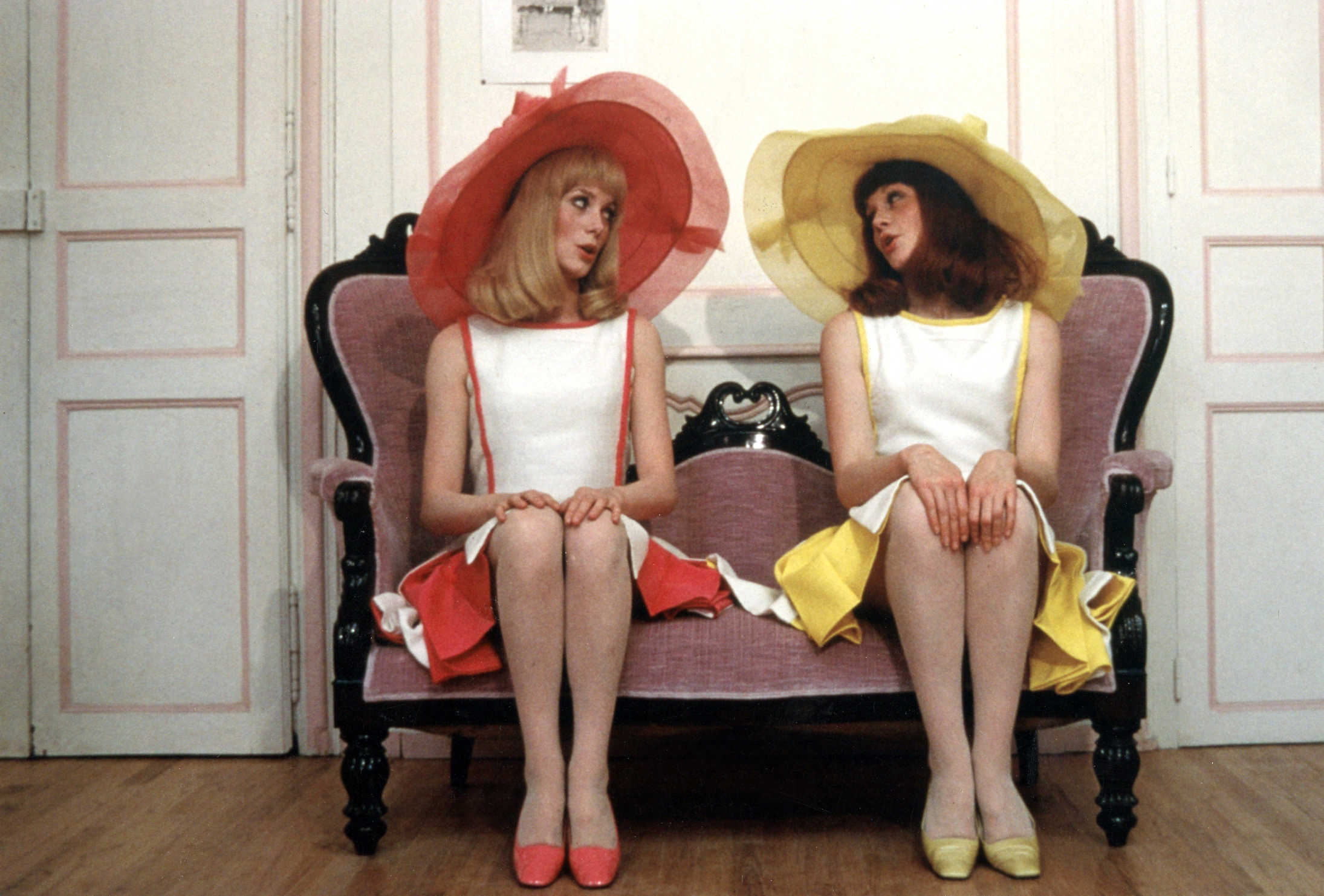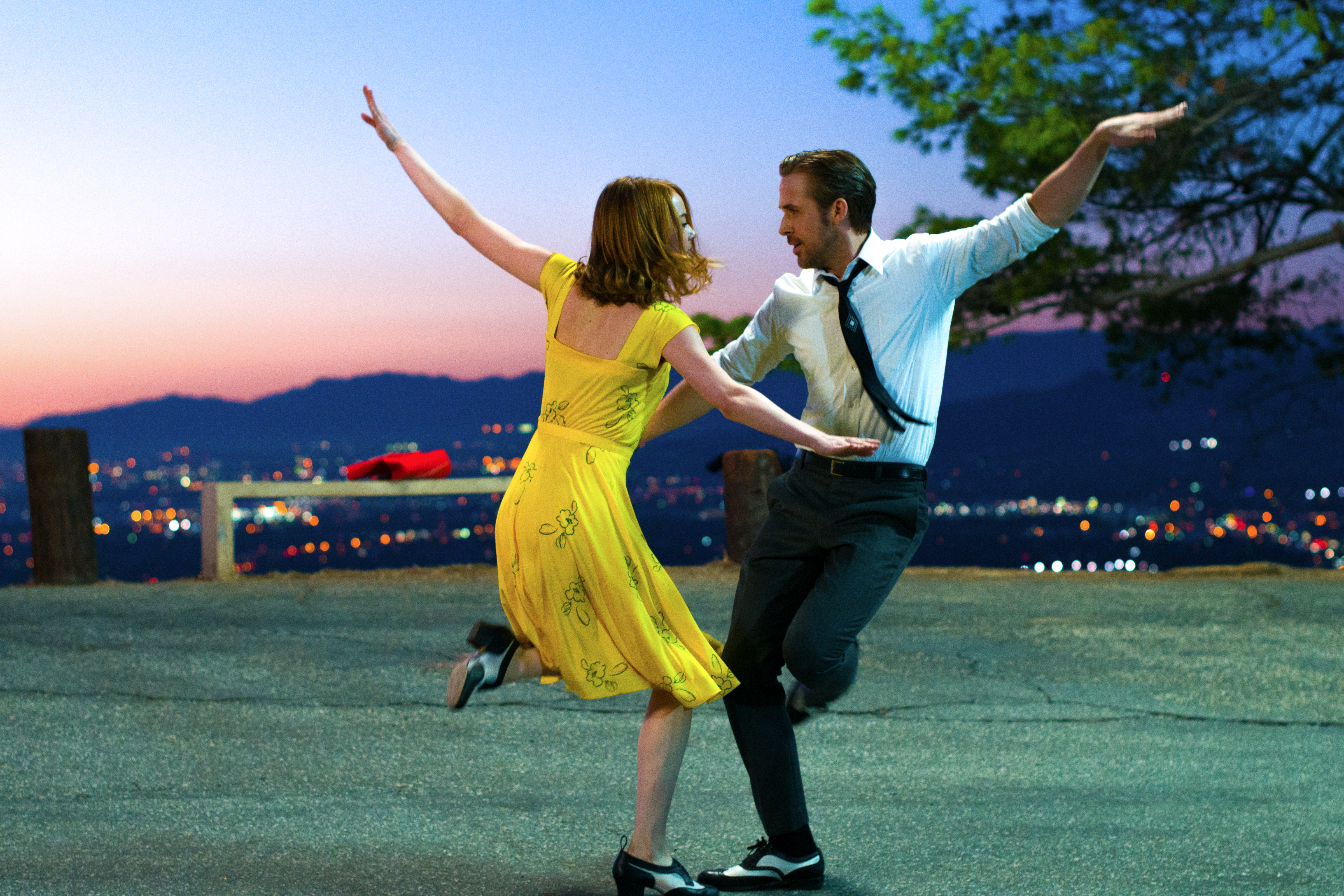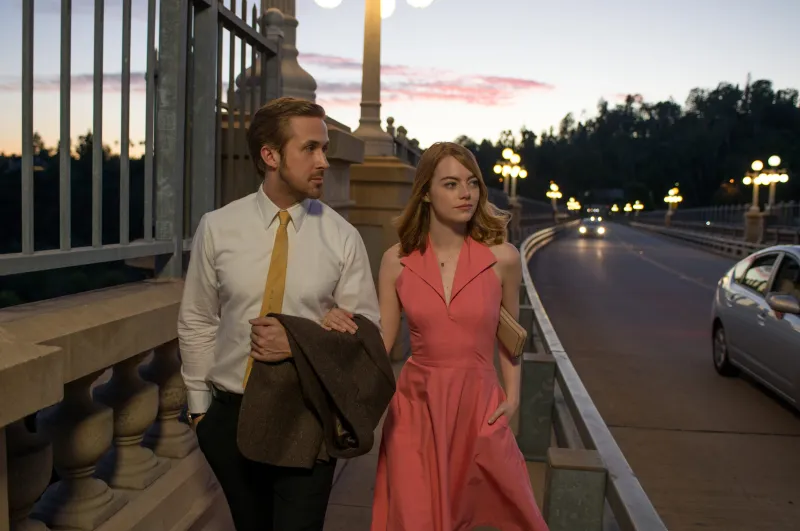“La La Land,” Damien Chazelle’s bittersweet product on the attempts to preserve the fading past, is much weirder than it seems. “Wouldn’t it be nice to go back to the days of nostalgic pining,” it seems to sing. But “La La Land” is too knowing, too familiar with the trappings of latching on to a love to ever suggest that as a positive alternative. Part of the power of its self-consciousness has to do with its patently false depiction of my beloved Los Angeles. Chazelle draws upon the tired LA cliché of “The City of Dreams,” but critiques its origins, mythology, why it pulls Millennial dreamers in.
In a bit of perverse humor, the opening number “Another Day of Sun” doesn’t depict Los Angeles traffic as a Katzenjammer clawing-of-throats à la Godard’s “Weekend” bougies. “Where’s the anger?” you ask yourself. Instead, Chazelle plops us into a mélange of hyped-up happiness and forced smiles. From the warm baby-blue of the sky, the camera sharply right-angles and drearily pans alongside a stretch of endless traffic-jam, with deeply dark color saturation smothering the scene. (The chiaroscuro bakes the dark-skinned freeway drivers, each a hollow and still-to-be-formed shell of a human.) A radio announcer chirps: “Another hot and sunny day in Southern California,” each word keyed in to a hollow, generic weightlessness and inaccuracy — what about the equally memorable rainy drizzle? The mechanically gliding camera sweeps past soupy, hot millennials in their trendy BMWs — all blaring different types of music that meld into cacophony. Soon, this is all harmonized by Schroeder’s piano-tinkling wafting from a trendy, brown-skinned girl’s stereo. She (Reshma Gajjar) leads the freeway drivers out of their cars and has them come together to mumble-cheer on Spanish flamenco dancers, African drummers in furniture vans, and Asian and black breakdancers hopping up and down in mock-rave lunacy, crafting a schizoid, swirling musical image for today. The credits haven’t rolled — are we sure this isn’t an ad for a Coca-Cola Christmas? It’s another confangled long-take, but with an edge. The number both indulges and mocks the current cinematic obsession for the Scene to be filmed in one showy, inorganic, unnecessary take.
This traffic-jam ditty is the only one set anywhere remotely near a run-down part of LA. Set atop the ramp that connects the 105 and 110 freeways, it’s true inner-city. Watts hovers soundlessly off to the camera’s right. The slightly sfumato’d downtown skyline is shown in foreshortened urban grimness. Maybe if you squint, you can see the South Central apartment I grew up in off to the left, near Crenshaw and Slauson.
Inevitably, Chazelle is going to get flak for using the same “Shot in LA” mistakes as all the other Hollywood directors before him. Basically, anything south of Wilshire and east of Culver City doesn’t exist. If it does, the location is mainly for postcard or jazz-album-cover decoration, as in the scene where Ryan Gosling and Emma Stone climb the Watts Towers.
Chazelle’s goal is a bit more complicated; though it doesn’t transcend these rookie mistakes, they aren’t done out of maliciousness or total ignorance. He manages to tap into the dreams of a young person living in Los Angeles, even a person from the parts of the city Hollywood movies hate to show. When looking at that CinemaScope/Technicolor screen, I don’t always want to be reminded of the abject poverty and misery from whence I came. Sometimes, I want a glint of hope and color and razzle-dazzle. Regardless whether it showed my part of town or not, rewatches of “La La Land” had me remembering all the times when, during an endless freeway trip in the back of my mom’s car, I conjured up endless fantasies about what I’d do if I ran into some money, how I would share it amongst my mom, sisters, grandmother, and myself. I’d look out at the city of smog and stars and marvel at the possibilities — what that convention center, or that marquee sign reading “ACADEMY,” or those bookstores might have holed up inside. The beauty of living, just for a day, on that mystical West Side — a seemingly unattainable goal at that age, but one within grasp in my head — was enough to keep me listening and watching movies aimlessly. As I got older, the fantasy expanded: I’d have that lovely person who’d complete me right by my side. Dreaming in color. Dreaming in widescreen.
* * *

“La La Land” is no exception to the cobbled-together eclecticism of musicals. They love permutation, remix, references forward and backward, thus achieving that treasured timelessness. In spades, “La La Land” calls forth the past for the present. On a Paramount movie set, an umbrella shop (Demy) stands underneath the window that Bogart and Ingrid Bergman look out from in “Casablanca.” A Millennial throwback-to-the-80s pool party plays Soft Cell’s “Tainted Love”, itself a synthy remake of the original, more soulful Gloria Jones single from 1965. The final musical number combines “The Red Balloon,” the garish expressionism of Ophuls’s “Lola Montes” and Powell and Pressburger’s “Tales of Hoffman”/”Red Shoes”/”Oh, Rosalinda!!”, sailors straight outta Rochefort, geometrically precise Busby Berkeley waltzes, and “Singin’ in the Rain“/”Bells are Ringing“ street lamps — into a postmodern bouillabaisse.
The typical “La La Land” image is incredibly top-heavy, garishly overcomposed. Its traffic-jam numbers, girlfriends goin’ out on the town, and nerdy jazz clubs flow with fossilized-in-amber frozenness and slickness. Creating his own la la land from LA realism, Chazelle crafts a precarious art-bubble that can burst at any moment. This bubble draws upon a smorgasbord of poignant effects to create its hologram charm:
- Wacky jewel tones with an abrasive, suicidal desperateness to them. Stone’s yellow sun dress, a pink streetlight clashing with Sandgren’s indigo skies, a “Vertigo” green used in Gosling’s and Stone’s fights.
- Cinematographer Linus Sandgren’s (“Joy”/”American Hustle”) twirly, ballerina pirouettes around the kissing couple.
- Along with #2, a camera pan which will start in a mundane mode (Gosling’s hands playing Christmas muzak) and, swiping around the back of someone’s head, end in a magical-realist mode (his hands melting into the strains of “Mia and Sebastian’s Theme”)
- Greenhorn Chazelle’s giddy use of CinemaScope linearity, stretchiness, and bulge copped from “The Young Girls of Rochefort”
- David O. Russell-like pushes and rushes into, around, over lovers’ faces, covering as many angles as Sandgren can juggle. (It has the look of an O. Russell film, but not quite the choppy, exhilarating rhythm.)
Though no imperfection seeps into the visuals, every incongruity enters the contaminated, quasi-naturalist performances, which surprise and delight in reminding us of the stars’ earthiness. Stone’s rushing voice quavers in “Audition (The Fools Who Dream)” conveying Melancholy and Fear of Failure. Gosling’s Brando-in-“Guys-and-Dolls” husk is similarly down-to-earth, grounding a sex star if only for the moment. Chazelle and Sandgren’s camera loves to linger on one of the two of them (usually Emma Stone) in heavenly pauses, showing how long-takes have been so under-utilized in the most basic dialogue scenes, and so over-utilized in sequences that don’t need to be a showy long-take.
All of this finagling and cross-referencing is shot in a distinctly David O. Russellian lens of whirling kinetics. Russell’s under-analyzed recent output could half be equated to the non-musical films of Minnelli: tight, personal yarns about families and overcoming shrill/shrieking social attacks, filtered through a dreamy (some incorrectly say “messy”) lens.
Musicals love contamination. The dream world spills into the ‘real.’ People always teeter on the verge of bursting into operatic spasms in a loud dialogue scene, and, contrariwise, sing-shout lines like, “The motor clicks a little when it gets cold, but that’s normal.” No surprises appear for those who know their musicals, and yet constant rewatches always pull the viewer into the world, as if they were watching it for the first time. Above all, the musical is a genre that traffics in glorious contradictions, of disjointed elements suddenly coming together to flow with action, spirit, purpose.
* * *

Los Angeles is a marvelous contradiction in itself. Every day on the freeway, the privileged run up against the lack-of-plenties, the rich against the poor, and the Santa Monica-white against the sun-baked brown. As someone from the latter groups, I could only dream of one day understanding that part of town with the huge white sign in the mountains. Like Stone and her actress-aunt, I had a TV, a decent DVD player, and a library packed to the nines with timeless classics. I, too, watched “Bringing Up Baby,” “Casablanca,” “Notorious” — mimicking the masterful displays of acting I saw in those Classic Hollywood films. How I pretended to be a hapless Cary Grant to a tough, brash Hepburn. Or a bashful Jack Lemmon with an equally mocked Shirley MacLaine, sharing in life’s miseries, but together.
I wasn’t quite like the brown-skinned girl who opens “Another Day of Sun.” No summer Sunday nights were spent in repertory theaters watching “Technicolor worlds made out of music and machine.” I didn’t know my Technicolor from my CinemaScope. That kind of movie-going knowledge was something my family could never do regularly, if ever — far too expensive, the theater in an even more inconvenient part of town, and I felt shy asking my then-estranged dad for a lift to the Pacific Theaters just to watch a movie I’d soon forget. (“Peter Pan“ and “Kill Bill: Volume 2″ stuck with me). But with those library DVDs, I (a movie Matilda) learned and grew anyway. Though words didn’t specifically exist to describe it, I was emotionally on the same wavelength as Stone and her aunt, Reshma Gajjar’s brown-skinned girl and that gut-punch lyric of hers: “It called me to be on that screen/And live inside each scene…”
Chazelle never captures the eerie and under-represented LA of films by Charles Burnett (“Killer of Sheep”), Sam Fuller (“The Crimson Kimono!”), Kent McKenzie (his unfathomably brilliant “The Exiles,” a look at Native Americans in the Bunker Hill neighborhood, circa 1961) or even our idol Jacques Demy, whose “Model Shop” is a depiction of LA ennui and alienation par excellence. He doesn’t have those filmmakers’ sense of the smallness of a subject; elephantine bigness, Ho’wood style, is his calling card. But what Chazelle can, and does, capture is LA’s conjured-up dreaminess — its magic realism — its fleeting web of togetherness. LA is a city haunted by its slowly-dissolving past — from the cinephilic pleasures of a South Pasadena movie theater called the Rialto (now boarded-up and ghost-like), to Hollywood’s mural of stars flaunting icons from Marilyn to Charlie, Shirley Temple to Jimmy Dean (cracking, pissed on and graffiti’d). The past Ryan and Emma are trying so desperately (and, in the end, hopelessly) to bring back eludes them. The past of a romantic moment. The past of a first encounter, the instant you fell in love with that person and the world seemed to harmonize for a blissful purple night or two. (Unfortunately, those love-wracked nights can’t all be shot by Linus Sandgren.) The past of movie musicals — of Vincente Minnelli, Bob Fosse, Jacques Demy, Stan “The Man” Donen, Gene Kelly, “West Side Story.” The past of revolutionary jazz, which thrives by surviving into the present and calling upon the forbearers of yesteryear.
In “La La Land,” the past has long passed. The characters don’t realize it until it’s too late. The present? Just a shotgun marriage of disparate threads which don’t hold the same cohesive resonances as they seemed to decades ago. The post-modern, Frankenstenian blendings of “La La Land” barely hold together, so precarious they are, so delicate, so easily torn apart. Nostalgia and the #aesthetic moment keep us obsessed with this past, one which keeps up locked in a perpetual state of frustration and anxiety because we can never go back to it. “La La Land” suggests this doe-eyed pining for “those lovely summer days” is delightful for the heart, dangerous for the head.
Something got weirdly lost when my transition from the inner city to the City of Stars took place. What was it? Every time I come home from school, I comb the streets of Hyde Park to find out. I watch the films of the LA Rebellion to relive that geographical past which is so different, and yet eerily the same. I experience musicals like those of Minnelli, Demy, and now Chazelle, to figure out the past. But alas — I mustn’t dwell in blanket nostalgia too long. Too many painful yet precious memories. I must look forward — yet how can I, when who I am today is so informed by who I was on that freeway at five, at ten, at fifteen, forgetting that each day was yet another day of sun?
*
Here are a few more thoughts upon a revisit of “La La Land,” March 17, 2017.
A shamelessly cynical work about narcissism and self-absorption, and how that’s the key to success. It is more honest than most works in revealing that basic human drive for selfishness, every person for themselves, success at the cost of a working ensemble. It’s reflected in the increasingly un-peopled frames, the narcissist’s greens and purples dominating the color spectrum, the blurring camera motions which finally focus in on our two heavies, the sheer lack of faith they have in the ensemble. Emma Stone’s one woman show. Gosling’s needs to save jazz by himself, only begrudgingly agreeing to work with John Legend because it will be the equivalent of a romantic “slummin’ it.”
Stone and Gosling’s sin is the sin of self-enclosure, of being so wrapped up in their own fantasy worlds that they forget the roving, diverse reality around them. When they nod to each other at the end, it is not an acknowledgment that they got everything they wanted, that they are “successful” emotionally or spiritually; rather, it is a manic-depressive, defeated gesture that acknowledges how much they now realize the limits of idealism, the limits of fantasy, their shared passion in the world lost to time, but the gnawing justification that “perhaps, it was worth it…”
This is the seductive and deceitful nature of romance: it leaves out the social, political. It distracts, it sweetens, it lightens. Chazelle does not. He is well aware of the political/racial/class-based stakes of the type of story he’s presenting — erasure is built into the very structure of La La Land‘s white success story, and it is never kidded or hand-waved away. In the most telling shot, the camera starts with the black jazz ensemble in focus, then slowly tracks back to the white couple foregrounded, listening in on them and talking over the black ensemble, out-of-focus. There is the frightening prospect weaving throughout the film that everyone’s knowledge of jazz, save the privileged very few “revolutionaries” (and Gosling is definitely not one of them), is just second-hand, third-rate, a dilution of a rich tradition and heritage.
In my experience, this critique reveals itself the more one stews in the La La Land universe, just like the shortcomings and flaws of the partner reveal themselves the more one stews in the relationship, or (alternately) the common ground of the seemingly unchangeable ignorant emerges.
Stream Justin Hurwitz’s ravishing “La La Land” score on Spotify here.
Contact Carlos Valladares at cvall96 ‘at’ stanford.edu.
